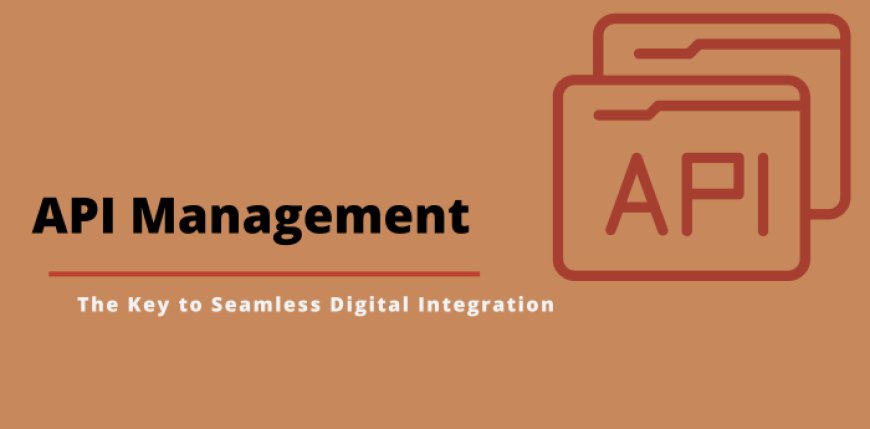API Management: The Key to Seamless Digital Integration

In today's digital economy, the use of Application Programming Interfaces has become ubiquitous, enabling applications, systems, and devices to connect and share information seamlessly. APIs are the glue that holds together the ecosystems of the modern business world, from enabling customer service chatbots to supporting e-commerce platforms. However, as businesses grow and scale, managing these APIs becomes increasingly complex, leading to the rise of API management solutions. In this blog post, we’ll explore what API management is, why it matters, its core components, and how businesses can leverage it to drive value.
What is API Management?
API management refers to the process of designing, deploying, securing, monitoring, and analyzing APIs in a consistent and controlled environment. An API management platform provides tools that help organizations manage their APIs across their entire lifecycle. This includes everything from API creation and testing to monitoring usage patterns, enforcing policies, and ensuring security.
At its core, API management allows companies to publish APIs to external or internal developers, handle the usage and performance of these APIs, and ultimately drive more business value by fostering a collaborative ecosystem. By using an API management platform, companies can enhance their capabilities, extend their service reach, and improve both internal and external communication and data sharing.
Why is API Management Important?
- Security and Access Control: QKS Group’s APIs are entry points into an organization's data and services, so protecting them is crucial. API management platforms enable robust security measures, including OAuth, OpenID, and JWT for authentication, along with encryption, IP whitelisting, and throttling. These measures prevent unauthorized access and protect data integrity.
- Scalability: As organizations expand, so does the need for their APIs to handle a growing number of users and interactions. API management helps distribute and balance the load across systems, ensuring that the API infrastructure can handle high traffic without compromising performance.
- Improved Developer Experience: Developers, both internal and external, are essential to the success of an API-driven strategy. API management provides tools such as API documentation, versioning, and sandbox environments, making it easier for developers to work with APIs effectively.
- Analytics and Monitoring: Real-time monitoring and analytics enable organizations to track API usage, response times, error rates, and other metrics. These insights help identify potential issues, optimize API performance, and gain a better understanding of how APIs are driving business outcomes.
- Revenue Generation: In some cases, APIs are not just tools but also products. Many companies monetize their APIs by charging for access or implementing tiered usage plans. API management enables companies to create a structured approach to monetization, allowing them to offer different access levels, enforce rate limits, and control the overall user experience.
Core Components of API Management
An effective API management strategy revolves around several key components that ensure the efficient lifecycle of APIs. Let’s look at some of the most critical components:
- API Gateway: An API gateway acts as a single-entry point for API requests. It routes requests from users to the appropriate backend services and provides security features such as rate limiting, authentication, and authorization. The gateway helps manage traffic and enforce policies to ensure a seamless user experience.
- Developer Portal: The developer portal is a central hub where developers can access API documentation, try out APIs in a sandbox, and view usage metrics. It serves as the face of an organization's API to developers, providing resources to help them integrate and use APIs effectively.
- Analytics and Monitoring Tools: Analytics tools within an API management platform track various metrics, such as API usage, response times, and error rates. Monitoring allows organizations to detect potential issues, analyze traffic patterns, and optimize the performance of their APIs.
- API Lifecycle Management: This component involves managing the entire lifecycle of an API—from initial design and testing to deployment and eventual retirement. Lifecycle management tools ensure that APIs are consistently updated, deprecated responsibly, and properly documented at every stage.
- Security and Access Control: Ensuring that APIs are secure is a critical function of API management. Security tools provide features like authentication, authorization, encryption, and IP whitelisting, helping prevent unauthorized access and data breaches.
- Policy Enforcement: Policy enforcement tools allow organizations to implement rules around API usage, such as rate limiting, quota management, and SLA (Service Level Agreement) enforcement. These policies protect APIs from misuse, ensure fair usage, and can prevent server overload.
How Businesses Can Benefit from API Management
In a digital-first world, businesses that manage their APIs effectively have a competitive advantage. Here are some ways API management can benefit organizations:
- Enhanced Customer Experience: By managing APIs effectively, companies can offer seamless experiences to customers, allowing them to access services across multiple channels without disruption.
- Accelerated Innovation: API management makes it easier for businesses to innovate and bring new services to market faster. Organizations can leverage third-party developers or partners to extend the reach and functionality of their services.
- Improved Operational Efficiency: Effective API management can reduce the operational overhead of maintaining and updating APIs. Automation of monitoring and scaling allows teams to focus on more strategic work.
- New Revenue Streams: For companies with valuable APIs, API management enables monetization by allowing businesses to charge for API access or offer subscription-based models.
- Stronger Partner Ecosystems: Many companies use APIs to collaborate with partners or offer access to data and services in a controlled way. API management helps ensure these partnerships are managed securely and effectively, fostering a thriving ecosystem.
Conclusion
As businesses continue to transform digitally, API management has become a fundamental component of a successful strategy. It allows organizations to extend their services, connect with partners, and provide a superior experience for developers and end-users alike. By implementing robust API management practices, companies can streamline operations, enhance security, and create new opportunities for growth and innovation. Whether you're a small startup or a large enterprise, investing in API management can help you thrive in today’s API-driven world.

 marketresearchblogi
marketresearchblogi